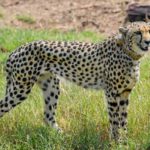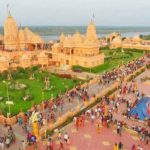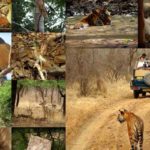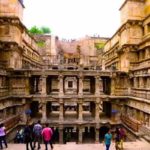Gir National Park is located near the coast of the far west-central part of India in the state of Gujarat. The national park area covers an area of 545 square miles (1,412 sq km). It is sometimes referred to as Sasan Gir.
The national park serves as a wildlife sanctuary focused on protecting the Asiatic lion population which has been increasing in recent years. The park is comprised of a dry deciduous forest with teak mixed in throughout. Collectively, the park is a hilly landscape of dry scrubland.
There are seven perennial rivers flowing through the park with four dams that have created four reservoirs. These water sources are some of the best places to catch the views of wildlife. The seven rivers are Datardi, Godavari, Hiran, Machhundri, Raval, Shetrunji, and Shingoda. Hiran, Machhundri, Raval, and Shingoda are the four rivers that have dams.
Although there are only 38 species of mammals, the collective wildlife accounts for over 2,300 species. Insects account for the majority with 300 species of birds and 37 species of reptiles. The Asiatic lion, Indian leopard, jungle cat, hyena, Desert cat, honey badger, and mongoose make up the predators of the park.
Other popular wildlife encounters include blackbucks, boar, chinkara, chital, four-horned antelope, nilgal, porcupine, rabbits, and sambar. Some of the popular reptiles include crocodile, Indian cobra, monitor lizard, and the tortoise.
There are over 500 species of vegetation creating the forest habitat. Teak and banyan trees are integrated throughout the abundant deciduous species. The varied forest vegetation makes a great home for the 300 species of birds as well as providing protection for many of the mammalian species Gir National Park.
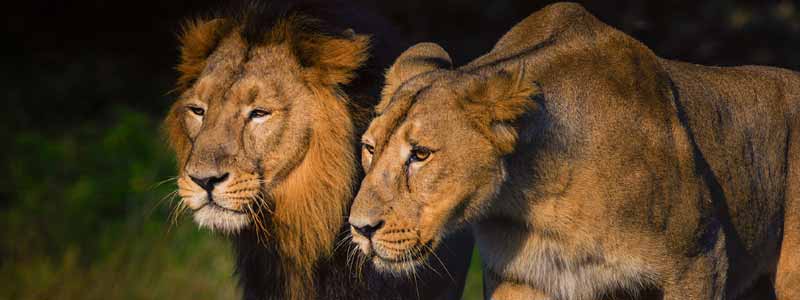
History of Gir National Park
The area of Gir National Park was once the hunting ground for the Britishers during their reign in India and while hunting these great numbers of tigers and lions accompanied by several Rajas and Maharajas of the region, it was considered as the matter of great pride. It was in the year 1899, the major counts of lions decreased sharply with the effect of famine and as a result Lord Curzon cancelled his trip in Gir which was scheduled for shooting upon invitation by the nawabs of the region.
The effect of famine was so great that Lord Curzon even advised the residents of the area to save the remaining lions. By the time to save the more vulnerable acts like hunting and poaching, the Government of India banned the hunting process in the area in the year 1960 and today with an approachable count of increase in lions the area is only available for photo safaris. Today the park is recognized as one of the most important protected areas in Asia due to its supported species. Gir National Park is accustomed of unique ecosystem with diverse flora and fauna and is now considered as one of the most important protected areas in Asia due to its unsupported species.
The various initiatives and efforts by the Indian Government and the NGOs brought many changes in the population of the Asiatic lions in the year. Where in 2005, the count rose to 359 and again during the April 2010, the reserve witnessed a greater rise in the count to reach by 52 as compared to 2005 ratio. The lion breeding program included the park and its surrounding area has bred about 180 lions in its captivity since its inception.
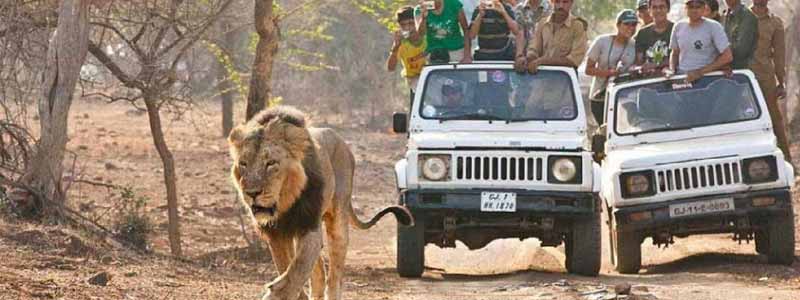
Safari Timing
Daily game drives in Open safari vehicles
06:30 AM to 08:30 AM,
08:30 AM to 10:30 AM and
03:00 PM to 05:30 PM.
Other Attractive Activities
- Bird Watching
- Devliya Safari Park
- The Maldharis Tribe Visit
- The Siddis Tribal Visit
- Crocodile Breeding
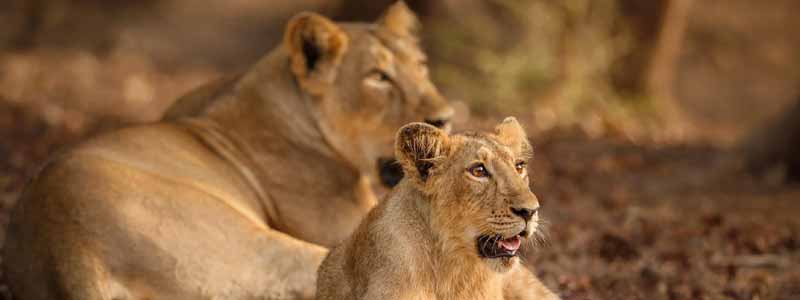
Tourist Attractions in Sasan Gir
Kamleshwar Dam : This is the most requisite dam in the area being built over the Hiran River. Located inside the vicinity of Gir National Park, the Kamleshwar Dam actually serves as a lifeline of the reserve area where the tourists can find great varieties of marsh crocodiles.
Tulsi Shyam Temple : This is a famous temple in the area dedicated to Lord Krishna. People make a sure shot visit to this temple where major hot springs near to the temple are the other major attraction.
Crocodile Breeding Farm : The Crocodile Breeding farm near the Sasan Gir Reserve is an appealing place to learn about the breeding of the crocodiles.
Fauna Of Gir Forest
The endless stretch of deciduous forest in the Gir National Park is the only place in Asia where you can find Asiatic lions roaming around freely in all their glory. However, the dense forest is not just home to these majestic carnivores but a host of other species and insects that make the place vibrant and diverse.
Established in 1965, this wildlife sanctuary was earlier a hunting ground for royal families and British officers. Today the area is one of the most extensive wildlife conservation sites in the country. Back in 1913, there were but 20 lions in the forest, the 2015 consensus shows a vast improvement in the situation with the population rising to 523 lions. Here are some of the animals that you can come across on your trip to the Sasan Gir Forest:
Mammals
Other than lions, you can also find herds of deer, leopards, hyenas, jackals, elephants, mongoose, and other mammals on land. There are two types of deer species found here- the popular Sambar and Chowsingha, the four-horned antelope. Striped Hyena, jackals, and India Fox are other common predators.
Birds
The Gir National Park is house of over 200 species of birds- ranging from common swallows to majestic peacocks. The national park also functions as a bird reserve, a title that was declared by the Bird Conservative Network. Bird watchers from across the world come over to the forest to spot species like the greenish yellow-footed pigeons, Griffon Eurasian vulture, hawk, eagle, Indian Pitta, Oriole to name a few.
Insects
As soon as you enter the forest, the chirruping of crickets greets you, piercing the stillness of the jungle. As you move on, you might come across other small creatures like worms, butterflies, bugs, grasshoppers among other things. There are over 2000 species of insects that were discovered by scientists in the past few decades. We would recommend that you carry a bug spray, carry jackets, Gir National Park and other medication with you to protect yourself from allergic reactions and skin inflammation.
Reptiles
Other than insects and birds, the Gir National Park reserve has a decent population of reptiles as well. There are roughly 37 new species of reptiles, ranging from frogs to snakes and scorpions and bees that researchers have discovered in the area. However, it is the marsh crocodile that steals the show, attracting tourists in large numbers. Snake lovers would be thrilled to discover species like the King Cobra, Russel’s viper, Krait, and saw-scaled vipers in the forest.
How to Reach Gir
Spread in the western region of India, the Gir National Park is one of the most visited wildlife reserves in India. Situated in the Junagadh district of Gujarat, the forest of Gir is easily accessible through railways, roadways and airways. The park is well associated with the successful conservation of the endangered Asiatic Lions. Wildlife enthusiasts from all over the world visit here to get the sight of the King of the forest in its natural habitat. There are many different options to reach Gir and here is the detailed information on visiting the Gir forest-
By Air : The Gir National Park can be accessed through the airways till the nearest airport which is Keshod airport. From the Keshod airport, one can take a taxi, cab or public transport to reach Gir Park. Keshod airport is located at about 90 km from the entrance of the Gir National Park. Apart from Keshod, the airport of Rajkot at around 140 km and the airport at the Diu airport at around 70 km away from the Gir is also an option to reach Gir. All these airports are connected to the other main International airports of India. One can hire a taxi or a cab or take the state transport bus to reach the reception of the Gir National Park.
By Rail : The nearest railhead to Gir is the Sasan Gir railway station, which is a local station connected to the other main railway stations in Gujarat. Junagadh and Veraval railway stations are the two main railheads near to the Gir National Park. Both the railway stations are located at an equal distance of around 75 km from Gir. You can hire a taxi or a cab from the station to reach the Gir National Park. The Rajkot railway station located around 165 km away from Gir can also be an option to reach Gir by the trains and then by the roadways.
By Bus : The roadway is the best way to reach Gir. The road connecting the major cities of Gujarat to the Gir is in good condition and there are taxis, cabs, private Buses and the state Buses available to reach Gir from the nearby cities like Junagadh, Ahmedabad, Surat, Dwarka, Jamnagar, etc.

